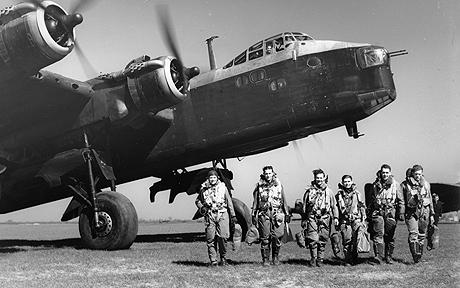The 622 Sqdn left from Mildenhall at 1943-11-19 at 17:10. Loc or duty Mannheim
He flew with a Short Stirling (type III, serial EF128, code GI-D).
Campaign report of the USAAF:
STRATEGIC OPERATIONS
(Eighth Air Force): VIII Bomber Command Mission 134: 127 of 161 B-17's and 3 of 6 B-17 PFF aircraft are dispatched to Gelsenkirchen, Germany but the malfunction of blind-bombing equipment and the weather causes the force to attack targets of opportunity on the German-Dutch border at 1241-1251 hours; 1 B-17 crashes after takeoff; the crew of 10 are KIA.
VIII Bomber Command Mission 135: 6 B-17's drop 2.316 million leaflets on Amiens and Reims, France; Brussels and Ghent, Belgium; and Amsterdam and The Hague, The Netherlands at 1915-2011 hours; no losses.
TACTICAL OPERATIONS
(Ninth Air Force): 100+ B-26's dispatched to attack airfields in France abort the mission when bad weather prevents rendezvous with the fighter escorts.
Campaign report of the RAF:
18/19 November 1943
The 'Battle of Berlin' begins
440 Lancasters and 4 Mosquitos were dispatched. Few German fighters intercepted the force. 9 Lancasters were lost, 2.0 per cent of the force. Berlin was completely cloud-covered and both marking and bombing were carried out blindly; Bomber Command could make no assessment of the results.
Major diversionary raid on Mannheim and Ludwigshafen by 395 aircraft - 248 Halifaxes, 114 Stirlings, 33 Lancasters - of Nos 3, 4, 6 and 8 Groups. German fighters successfully engaged the bomber force and 23 aircraft - 12 Halifaxes, 9 Stirlings, 2 Lancasters - were lost, 5.8 per cent of the force.
Cloud was present over the target area and much of the bombing was scattered. 21 people were killed, 154 injured and 7,500 bombed out. Many bombs fell outside the city and the local report lists much damage and loss at farms.This was the last major raid on the much-bombed city of Mannheim for 15 months.
10 Mosquitos to Essen, 6 to Aachen and 6 to Frankfurt, 16 Wellingtons minelaying from Texel to St Nazaire, 7 OTU sorties.
Total effort for the night: 884 sorties, 32 aircraft (3.6 per cent) lost.
19/20 November 1943
Leverkusen bombed by 266 aircraft - 170 Halifaxes, 86 Stirlings, 10 Mosquitos - of Nos 3,4,6 and 8 Groups. Only 4 Halifaxes and 1 Stirling - 1.9 per cent of the force - lost; very few German fighters were operating, probably because of bad weather at their airfields. Failures of equipment prevented most of the Oboe marking being carried out and other Pathfinder aircraft were unable to mark the target properly in difficult weather conditions, leading to bombs being scattered over a wide area. At least 27 towns, mostly well to the north of Leverkusen, recorded bombs. Leverkusen's own records show only one high-explosive bomb in the town!
6 Mosquitos to Duisburg and 2 to Rheinhausen, 25 aircraft minelaying off Biscay ports, 11 OTU sorties. No losses. Many of the aircraft returning from operations encountered fog conditions on reaching England and 2 Halifaxes and 1 Stirling crashed, but 4 Halifaxes of No 35 Squadron landed safely at Graveley when the first operational use was made of the oil-burning fog dispersal equipment called FIDO (Fog Investigation Dispersal Operation), which was installed at Graveley airfield. Several other airfields were soon fitted with this useful device.
With thanks to the RAF and USAAF.net!
This record can also be found on the maps of Back to Normandy with Google coordinates. You can find the maps by clicking on this link on this location.
There are several possibilities to investigate the flight records on Back to Normandy. All the flights are plotted on maps, sorted "day by day", "by squadron", "by type aircraft", "by year or month", "by location" and much more! Don't miss this!!!
If you have any information that you want to share, please add your comment at the bottom of this record. Or send your information to [email protected]. This information will be added to the record.
Your photos and your information are very welcome! The young do care and with your help we keep up the good work.



